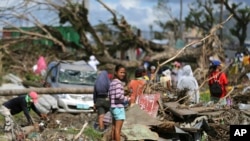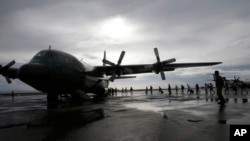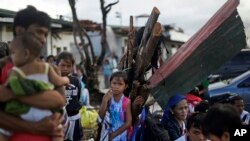MANILA —
After super Typhoon Haiyan struck the Philippines last November, foreign governments and aid groups pledged some $600 million in cash and assistance for the relief and recovery effort. Now, the Philippine government says it can only account for some $14.3 million of the donations. The government is working to create an improved tracking system to find out where the money went.
Right now the “Foreign Aid Transparency Hub” website shows pledges to three Philippine government agencies, but there are holes in the data.
Presidential spokesman Edwin Lacierda admits that the website does not reflect where exactly the money is going. But he says the government will remedy that situation this month with an updated version that will provide more transparency.
“We are not going to only track donations to government, but also [what] those pledges and assistance have been converted to and to what channels- what we call channels- or organizations that they’re going to be furnished to," said Lacierda.
Foreign governments accounting
For the new version, the Philippines will require foreign governments to submit detailed information of where their pledges have gone. Authorities say this will help them account for much more of the donated funds. As for tracking what the Philippine government has received directly, Lacierda says those agencies are still putting together reports of where the money was spent.
Cleo Calimbahin, the executive director of Transparency International-Philippines, commends the government for creating the website, but she says it is “not very informative.” And even with additional information in the new version, the huge gap between pledges versus cash accepted might not necessarily close.
“A lot of private organizations and agencies channeled some of [that] aid directly to their counterparts… and that would be very difficult to track. Also difficult to track would be aid that was given directly to local governments… because sometimes these local governments have strong relationships with other countries directly,” she said.
Ramon Casiple, who heads the Philippine Institute for Political and Electoral Reform, says improved transparency about the government’s projects for aid and recovery would be better than an improved aid tracking website.
“The public can look into these plans, the way that they are implemented and actually give access to the victims themselves, if you want to verify the facts or the information. The whole problem, so far in the rehabilitation, is that the victims are not part of the story,” he said.
Casiple says some of the bigger aid agencies worry about corruption and so they hesitate to donate directly to governments. Also, down on the ground at the local government level, politics can influence whether survivors will get help or not.
Relief operations in the Philippines, Nov. 21, 2013
Agencies have own tracking systems
Casiple points to Oxfam International, which has so far collected $55 million toward typhoon aid, as a model for efficiency in helping the neediest survivors. He says agencies like Oxfam work closely with their local counterparts on the ground.
An Oxfam spokeswoman says all donations collected go toward Haiyan relief and rehabilitation. The money is administered through a management system that follows projects at each step of the process.
Another major humanitarian agency, the Tzu Chi Foundation, works directly with the survivors. Philippine Country Chief Alfred Li says Tzu Chi has so far poured more than $27 million into areas that were hit hardest by Haiyan. He says the money is tracked from start to finish and Tzu Chi personnel and volunteers are on the ground carrying out the work.
“Whatever we spend is handled by us. We never give it to the government and then let the government do the distribution. All our relief activities are always done by ourselves,” he said.
The funds have gone toward cash and livelihood relief and now building schools and other recovery work. Li says Tzu Chi submits reports directly to the Departments of Social Welfare, Education and other related agencies.
After five months of recovery and reconstruction efforts in Tacloban and other hard-hit areas, there is still a great need for more assistance. Just this week, Australia pledged another $27 million for reconstruction in typhoon-hit areas, on top of the $36 million Canberra pledged in November.
Images from the Philippines, Nov. 21, 2013
Right now the “Foreign Aid Transparency Hub” website shows pledges to three Philippine government agencies, but there are holes in the data.
Presidential spokesman Edwin Lacierda admits that the website does not reflect where exactly the money is going. But he says the government will remedy that situation this month with an updated version that will provide more transparency.
“We are not going to only track donations to government, but also [what] those pledges and assistance have been converted to and to what channels- what we call channels- or organizations that they’re going to be furnished to," said Lacierda.
Foreign governments accounting
For the new version, the Philippines will require foreign governments to submit detailed information of where their pledges have gone. Authorities say this will help them account for much more of the donated funds. As for tracking what the Philippine government has received directly, Lacierda says those agencies are still putting together reports of where the money was spent.
Cleo Calimbahin, the executive director of Transparency International-Philippines, commends the government for creating the website, but she says it is “not very informative.” And even with additional information in the new version, the huge gap between pledges versus cash accepted might not necessarily close.
“A lot of private organizations and agencies channeled some of [that] aid directly to their counterparts… and that would be very difficult to track. Also difficult to track would be aid that was given directly to local governments… because sometimes these local governments have strong relationships with other countries directly,” she said.
Ramon Casiple, who heads the Philippine Institute for Political and Electoral Reform, says improved transparency about the government’s projects for aid and recovery would be better than an improved aid tracking website.
“The public can look into these plans, the way that they are implemented and actually give access to the victims themselves, if you want to verify the facts or the information. The whole problem, so far in the rehabilitation, is that the victims are not part of the story,” he said.
Casiple says some of the bigger aid agencies worry about corruption and so they hesitate to donate directly to governments. Also, down on the ground at the local government level, politics can influence whether survivors will get help or not.
Relief operations in the Philippines, Nov. 21, 2013
Agencies have own tracking systems
Casiple points to Oxfam International, which has so far collected $55 million toward typhoon aid, as a model for efficiency in helping the neediest survivors. He says agencies like Oxfam work closely with their local counterparts on the ground.
An Oxfam spokeswoman says all donations collected go toward Haiyan relief and rehabilitation. The money is administered through a management system that follows projects at each step of the process.
Another major humanitarian agency, the Tzu Chi Foundation, works directly with the survivors. Philippine Country Chief Alfred Li says Tzu Chi has so far poured more than $27 million into areas that were hit hardest by Haiyan. He says the money is tracked from start to finish and Tzu Chi personnel and volunteers are on the ground carrying out the work.
“Whatever we spend is handled by us. We never give it to the government and then let the government do the distribution. All our relief activities are always done by ourselves,” he said.
The funds have gone toward cash and livelihood relief and now building schools and other recovery work. Li says Tzu Chi submits reports directly to the Departments of Social Welfare, Education and other related agencies.
After five months of recovery and reconstruction efforts in Tacloban and other hard-hit areas, there is still a great need for more assistance. Just this week, Australia pledged another $27 million for reconstruction in typhoon-hit areas, on top of the $36 million Canberra pledged in November.
Images from the Philippines, Nov. 21, 2013











